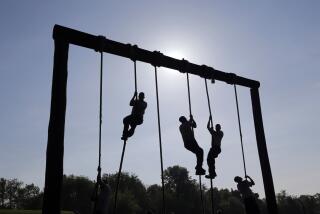Navy Can’t Afford to Stumble and Fumble Its Way Into Battle
- Share via
The Persian Gulf conflict has provided more combat experience for the U.S. Navy than has any other event since World War II. In fact, except for World War II, the seagoing vessels of the U.S. Navy have been fired at for only about 100 hours in the Navy’s two centuries of existence.
Now that’s both good news and bad news. The good news is that the naval deterrent works and we rarely have to fight. Yet the bad news is that we aren’t as well prepared as we ought to be for those rare conflicts.
I am not saying that the Navy’s crews are ill trained. I am simply saying that the officers and men of the Navy lack combat experience, and that the episodic nature of sea conflicts means that they are not likely to get much of it.
When an army goes to war, it stumbles and fumbles as it seeks to make the unreality of training fit the reality of combat. Armies generally have time in which to adjust to the stress and unfamiliarity of combat. But a navy that commonly sees only a few hours of combat each generation doesn’t enjoy that luxury. It is judged on what it does in a brief time.
Since World War II, the Navy’s air crews over Vietnam and Korea and its river-patrol forces in Vietnam saw extensive combat. But the seagoing Navy has been shot at only sporadically--in such instances as the Tonkin Gulf episode in 1964, the Liberty in 1967, the Pueblo in 1968,the Mayaguez rescue in 1975. There were also tense moments for the ships and crews stationed off such unpleasant locales as Korea in the 1950s, Vietnam in the 1960s and Libya and Lebanon in the 1980s.
The Persian Gulf saw two battles with the Iranians-one on April 18 and the other on July 3, during which the cruiser Vincennes shot down an Iranian passenger plane. And the Navy saw more stressful work in the gulf, too, as it spent one year under the constant threat of mines and Iranian patrol boats.
In part because of the way we rotate ships and crews in and out of the Persian Gulf, no one who participated in the April 18 battle was around to help in the Vincennes’ July 3 battle. There were no battle-hardened warriors on the scene. The crew was green when the battle began.
And it showed. Despite all the training that the crew of the Vincennes received, the reality of battle was something new and nerve-racking.
We can tell how nerve-racking it was from the unique electronic record kept by the Aegis system aboard the Vincennes. It recorded such details as the precise moment in which every button was touched and every toggle switched in the Vincennes’ command center.
Because of this record, we know that one officer, who was prompted by the computer to “select weapon system” as the countdown to the destruction of the Airbus began, hit the wrong buttons five times before he realized that he was supposed to select a weapon. And we also know that another member of the Vincennes’ crew was so agitated that he got ahead of the firing sequence and pushed another button 23 times before it was an appropriate part of the procedure.
I don’t recount these errors to pick on the crew. I recount them because I believe that they must be considered the norm when inexperienced humans face a sudden stressful encounter.
We need to recognize the rarity of naval combat--and then plan to take this obvious fact into consideration. First, we could make a point of screening potential crewmen to eliminate those most easily disoriented by stress. Currently we judge men on their ability to master the intricacies of modern equipment--in a non-stressful environment. But that doesn’t necessarily mean that we will get the kind of performance that we want in the only circumstances for which we are training them.
We should also try harder to simulate stress in training. This is a tall order. The only way to produce the kind of stress generated by a life-threatening situation is to threaten life--and we are not about to do that in training. But we need to hunt for surrogates, even if they do not fully fill the bill.
If we are faced with another Persian Gulf situation, we could do a better job of rotating crewmen. The Vincennes, for example, had been in the region 45 days and no one aboard knew the flight schedule for Iran Air. When I visited the gulf last year, I remember one seaman who had been there for many months pointing to a map and saying, “And Iran Air sends a plane down this corridor Tuesdays and Thursdays at 1500 hours.”
We could have rotated the crewmen in such a way that every ship had a few “old hands” on board. If the seaman I met had been aboard the Vincennes on July 3, perhaps the skipper would not have fired. That’s an “if” that we can never know.
But what we do know is that the next dust-up that the Navy faces is likely to be short--short in time and short in terms of combat-experienced crewmen.
We ought to plan with those two “shorts” in mind.
More to Read
Sign up for Essential California
The most important California stories and recommendations in your inbox every morning.
You may occasionally receive promotional content from the Los Angeles Times.












